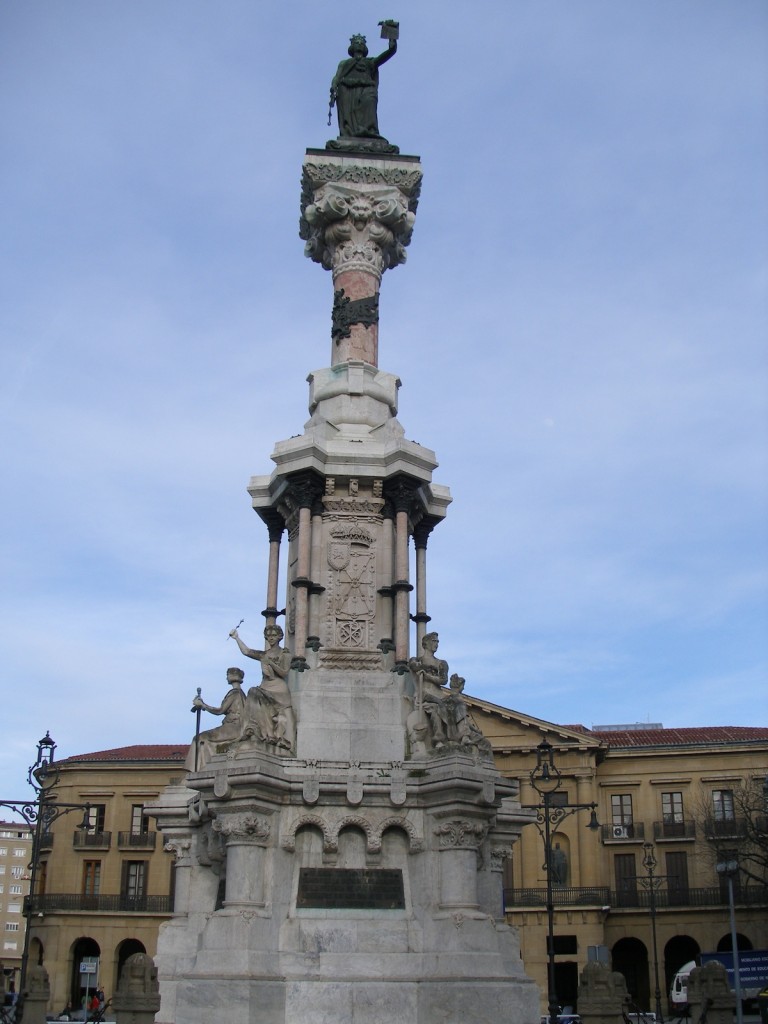This article was translated by John R. Bopp
(originally published in Spanish here).
At the end of the 19th century, when the wounds of the last Carlist war and the complete abolition of the fueros were still fresh in the minds of the Basques south of the Pyrenees, the Government of the Kingdom of Spain wanted to tighten Spanish control over the Basque lands even more. Minister Germán Gamazo wanted to erase the fuero-based tax system Navarre had established with the “Paccionada” Law of 1841.
That decision, which was unconstitutional in today’s terminology, strongly motivated the Basques on the peninsula, not only in Navarre, but also in Araba, Biscay, and Gipuzkoa. The Navarrese realized that these fraternal territories were on their side, despite their governors’ decisions to reach an agreement in 1841 with the “Paccionada” Law, which was agreed on behind the backs of the other Basque territories and the Navarrese themselves.


This Basque solidarity led to a fuerist movement which, given the strength it reached and its proximity to the last Carlist war, worried Spanish and Navarrese leaders, which, looking back, we can understand. In the marches in Pamplona, and in the welcoming committee in Castejón for the Navarrese negotiators who had fruitlessly tried to the keep the Gamazo Law from reaching parliament, were the first Basque nationalists with their leader at the helm. Sabino Arana, the founder of the Basque Nationalist Party and the father of modern Basque nationalism learned on this trip to Navarre that his movement would have to be dedicated to the Basque nation as a whole, and not just to one of its territories, as he had originally thought. He learned this after attending marches and acts in defense of the fueros, and after meeting some of the Basque from this territory who would later be at the vanguard of Basque nationalism in Navarre.
As the Spanish-language Wikipedia clearly explains:
The defense of the ‘fuero’ system strengthened the union with the other three Provinces that shared the system (Biscay, Alava, Guipuzcoa), sharing a cause, reviving the slogan “Laurak Bat” (union of four). The people, unlike the position of the Navarre se Government, hit strongly with political content demanding to recoup the sovereignty lost in 1839 with the Decree of the Confirmation of the ‘Fueros’.
In 1903, due to popular subscription and without any official inauguration on the part of the Navarrese authorities, a Monument to the Fueros was raised in front of the Navarrese government building. It was not Basque nationalists who wrote the plaques that state the will of the Navarrese when the moment was erected, it was the Navarrese themselves, at the beginning of the 20th century, who did so.
In it, you can read how the Navarrese felt, which has been fought since then, and which seems to enjoy a certain level of success among those Navarrese who have governed Navarre since the Spanish-Aragonese invasion of the 16th century, and by the Government of Spain, which seems to have the goal of making a homogeneous state.
Navarre, without a doubt, like the remaining Basque provinces south of the Pyrenees were, are, and will be a serious obstacle for the creation of that new reality that they want to exist at the expense of finishing off other realities that are over a thousand years old. Which option will end up winning out depends on two things:
- on the ability of the Basques to know who they are and where they come from
- on the ability of the Basques to stay together
The texts on the plaques are clear as day:
1.- “SE ERIGIÓ ESTE MONUMENTO PARA SIMBOLIZAR LA UNIÓN DE LOS NAVARROS EN LA DEFENSA DE SUS LIBERTADES, LIBERTADES AÚN MÁS DIGNAS DE AMOR QUE LA PROPIA VIDA”. (This monument was built to symbolize the union of the Navarrese in defense of their freedoms, freedoms even more worthy of love than life itself)
2.- “LA INCORPORACIÓN DE NAVARRA A LA CORONA DE CASTILLA FUE POR VÍA DE UNIÓN PRINCIPAL, RETENIENDO CADA REINO SU NATURALEZA ANTIGUA, ASÍ EN LEYES COMO EN TERRITORIO Y GOBIERNO”. (The incorporation of Navarre to the Crown of Castile was by means of Main Union, while each kingdom kept its former nature, in laws as well as in territory and government)
3.- “JURABAN NUESTROS REYES GUARDAR Y HACER GUARDAR LOS FUEROS, SIN QUEBRANTAMIENTO ALGUNO, MEJORÁNDOLOS SIEMPRE Y NUNCA EMPEORÁNDOLOS, Y QUE TODA TRANSGRESIÓN A ESTE JURAMENTO SERÍA NULA, DE NINGUNA EFICACIA Y VALOR”. (Our kings swore to keep and protect the ‘fueros’, without breaking any of them, improving them always and never worsening them, and that any transgression to this oath would be null, of no efficacy or value)
4.- “GU GAURKO EUSKALDUNOK GURE AITASOEN ILLEZKORREN OROIPENEAN, BILDU GERA EMEN GURE LEGEA GORDE NAI DEGULA ERAKUSTEKO”. (We, the Basques of today, have met here to the immortal memory of our ancestors, to show that we want to continue maintaining our law.)
5.- “GU EUSKALDUNOK BESTE JAUN EZTEGU JAUNGOIKOA BAIZIK, ATZEKOARI OSTATUA EMATEN DEGU ONIRIZKERO BAINO EZTEGU NAI AIEN UZTARRIA JAZAN. ADITU EZAZUE ONDO, GURE SEMEAK”. (We Basques, have no Lord but God. We welcome the foreigner with hospitality, but we will not wear his yoke. Listen well, children of ours)
That is the Spirit of Navarre, written by the Navarrese. The Monument to the ‘Fueros’ in a place that should regularly be visited by all Basques, so that we don’t forget who we are and what our grandparents believed and did.
We Propose a Symbolic and Necessary Act: The Inauguration of the Monument to the ‘Fueros’ of 1903
Information about this important part of the history of the Basques:
Las placas del Monumento a los Fueros
Wikipedia: Los nacionalistas vascos en la Gamazada
Wikipedia: La ley paccionada de Navarra
Last Updated on Aug 6, 2022 by About Basque Country





























